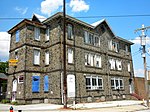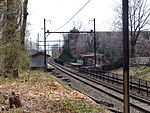Loudoun Mansion
1801 establishments in PennsylvaniaGermantown, PhiladelphiaHistoric district contributing properties in PennsylvaniaHouses completed in 1801Houses on the National Register of Historic Places in Philadelphia ... and 2 more
NRHP infobox with nocatUse mdy dates from August 2023

The Loudoun Mansion is an historic, American house that is located in the Germantown neighborhood of Philadelphia, Pennsylvania.A contributing property of the Colonial Germantown Historic District, it was damaged by fire in 1993 and is not open to the public.
Excerpt from the Wikipedia article Loudoun Mansion (License: CC BY-SA 3.0, Authors, Images).Loudoun Mansion
Germantown Avenue, Philadelphia
Geographical coordinates (GPS) Address Nearby Places Show on map
Geographical coordinates (GPS)
| Latitude | Longitude |
|---|---|
| N 40.026111111111 ° | E -75.16 ° |
Address
Germantown Avenue 4661
19144 Philadelphia
Pennsylvania, United States
Open on Google Maps











